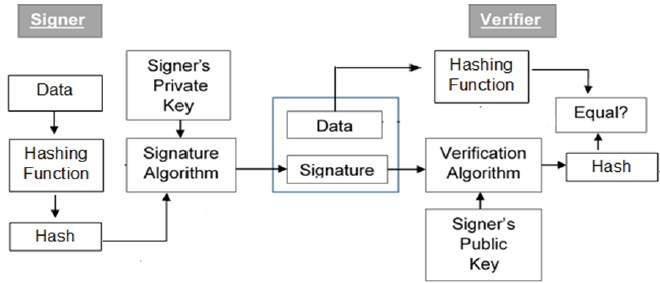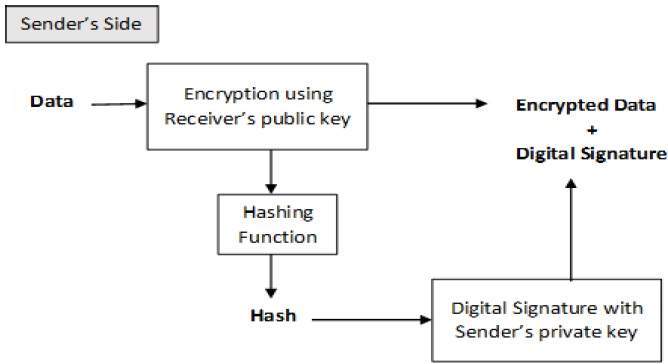Digital signatures are the public-key primitives of message authentication. In the physical world, it is common to use handwritten signatures on handwritten or typed messages. They are used to bind signatory to the message.
Similarly, a digital signature is a technique that binds a person/entity to the digital data. This binding can be independently verified by receiver as well as any third party.
Digital signature is a cryptographic value that is calculated from the data and a secret key known only by the signer.
In real world, the receiver of message needs assurance that the message belongs to the sender and he should not be able to repudiate the origination of that message. This requirement is very crucial in business applications, since likelihood of a dispute over exchanged data is very high.
Model of Digital Signature
As mentioned earlier, the digital signature scheme is based on public key cryptography. The model of digital signature scheme is depicted in the following illustration −

The following points explain the entire process in detail −
- Each person adopting this scheme has a public-private key pair.
- Generally, the key pairs used for encryption/decryption and signing/verifying are different. The private key used for signing is referred to as the signature key and the public key as the verification key.
- Signer feeds data to the hash function and generates hash of data.
- Hash value and signature key are then fed to the signature algorithm which produces the digital signature on given hash. Signature is appended to the data and then both are sent to the verifier.
- Verifier feeds the digital signature and the verification key into the verification algorithm. The verification algorithm gives some value as output.
- Verifier also runs same hash function on received data to generate hash value.
- For verification, this hash value and output of verification algorithm are compared. Based on the comparison result, verifier decides whether the digital signature is valid.
- Since digital signature is created by ‘private’ key of signer and no one else can have this key; the signer cannot repudiate signing the data in future.
It should be noticed that instead of signing data directly by signing algorithm, usually a hash of data is created. Since the hash of data is a unique representation of data, it is sufficient to sign the hash in place of data. The most important reason of using hash instead of data directly for signing is efficiency of the scheme.
Let us assume RSA is used as the signing algorithm. As discussed in public key encryption chapter, the encryption/signing process using RSA involves modular exponentiation.
Signing large data through modular exponentiation is computationally expensive and time consuming. The hash of the data is a relatively small digest of the data, hence signing a hash is more efficient than signing the entire data.
Importance of Digital Signature
Out of all cryptographic primitives, the digital signature using public key cryptography is considered as very important and useful tool to achieve information security.
Apart from ability to provide non-repudiation of message, the digital signature also provides message authentication and data integrity. Let us briefly see how this is achieved by the digital signature −
- Message authentication − When the verifier validates the digital signature using public key of a sender, he is assured that signature has been created only by sender who possess the corresponding secret private key and no one else.
- Data Integrity − In case an attacker has access to the data and modifies it, the digital signature verification at receiver end fails. The hash of modified data and the output provided by the verification algorithm will not match. Hence, receiver can safely deny the message assuming that data integrity has been breached.
- Non-repudiation − Since it is assumed that only the signer has the knowledge of the signature key, he can only create unique signature on a given data. Thus the receiver can present data and the digital signature to a third party as evidence if any dispute arises in the future.
By adding public-key encryption to digital signature scheme, we can create a cryptosystem that can provide the four essential elements of security namely − Privacy, Authentication, Integrity, and Non-repudiation.
Encryption with Digital Signature
In many digital communications, it is desirable to exchange an encrypted messages than plaintext to achieve confidentiality. In public key encryption scheme, a public (encryption) key of sender is available in open domain, and hence anyone can spoof his identity and send any encrypted message to the receiver.
This makes it essential for users employing PKC for encryption to seek digital signatures along with encrypted data to be assured of message authentication and non-repudiation.
This can archived by combining digital signatures with encryption scheme. Let us briefly discuss how to achieve this requirement. There are two possibilities, sign-then-encrypt and encrypt-then-sign.
However, the crypto system based on sign-then-encrypt can be exploited by receiver to spoof identity of sender and sent that data to third party. Hence, this method is not preferred. The process of encrypt-then-sign is more reliable and widely adopted. This is depicted in the following illustration −

The receiver after receiving the encrypted data and signature on it, first verifies the signature using sender’s public key. After ensuring the validity of the signature, he then retrieves the data through decryption using his private key.